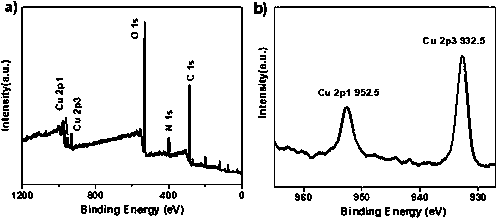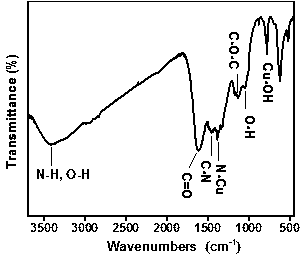Novel copper-doped-carbon-nano-dot-based method for enzyme-ratio-free fluorescence detection of organophosphorus pesticide
A technology of organophosphorus pesticides and carbon nano-dots, which is applied in the fields of nanomaterials, catalysis and chemical sensing, can solve the problems of preparation and application that have not been reported yet, and achieve the effects of good selectivity, simple operation method and good reproducibility
- Summary
- Abstract
- Description
- Claims
- Application Information
AI Technical Summary
Problems solved by technology
Method used
Image
Examples
Embodiment 1
[0028] Preparation of copper-doped carbon nanodots:
[0029] 40 mg of anhydrous copper chloride, 180 mg of tris(hydroxymethyl)aminomethane and 10 mg of L-dopa were dissolved in 40 mL of ultrapure water, and then placed in a hydrothermal reactor at 180°C for 4 hours. The above reaction solution was centrifuged at 12000 r / min for 10 min and filtered with a 0.22 μm microporous membrane to remove large-sized particles generated during the reaction, and finally freeze-dried and dispersed in ultrapure water for later use.
Embodiment 2
[0031] Morphology and performance analysis of copper-doped carbon nanodots:
[0032] figure 1 The transmission electron microscope image of the synthesized copper-doped carbon nanodots shows that the synthesized copper-doped carbon nanodots have an approximately spherical structure, the particle size distribution is between 20 and 40 nm, and the average size is 25 nm. Monodispersity and stability, it emits strong blue fluorescence under 365 nm UV lamp.
[0033] figure 2 X-ray photoelectron spectroscopy (XPS) of the as-synthesized copper-doped carbon nanodots. It can be seen from XPS that copper-doped carbon nanodots contain four elements, C, N, O and Cu, and their contents are 55.06%, 10.38%, 33.51% and 1.05%, respectively. It can be seen from the Cu2pXPS spectrum that two strong peaks appear at 932.5 ev and 952.5 ev, corresponding to Cu(0) and Cu(I), respectively. Therefore, the present invention successfully synthesizes copper-doped carbon nano-dots, and the valence sta...
Embodiment 3
[0043] Taking the detection of methapon as an example, the process of detecting organophosphorus pesticides in the present invention is illustrated: take 50 μL of copper-doped carbon nano-dots (10mg L -1 ), add 100 μL of different concentrations (0 ~ 500 μg·L -1 ) methapon solution, then add 100 μL hydrogen peroxide (50mmol·L -1 ) and 100 μL freshly prepared o-phenylenediamine (5 g L -1 ), dilute to 1 mL with ultrapure water, mix well and react at room temperature (25 °C) for 20 minutes, then place it on a fluorometer for fluorescence testing, and record the presence of different concentrations of killing agents in the system when the excitation wavelength is 330 nm. Phosphorus fluorescence spectrum ( Figure 6 ), record the fluorescence intensity ratio I of the reaction system at 375 nm and 555 nm 375 / I 555 ,Such as Figure 7 Shown, the fluorescence intensity ratio I 375 / I 555 By plotting the concentration of methapion and performing linear fitting, the standard work...
PUM
| Property | Measurement | Unit |
|---|---|---|
| Average size | aaaaa | aaaaa |
Abstract
Description
Claims
Application Information
 Login to View More
Login to View More - R&D
- Intellectual Property
- Life Sciences
- Materials
- Tech Scout
- Unparalleled Data Quality
- Higher Quality Content
- 60% Fewer Hallucinations
Browse by: Latest US Patents, China's latest patents, Technical Efficacy Thesaurus, Application Domain, Technology Topic, Popular Technical Reports.
© 2025 PatSnap. All rights reserved.Legal|Privacy policy|Modern Slavery Act Transparency Statement|Sitemap|About US| Contact US: help@patsnap.com



